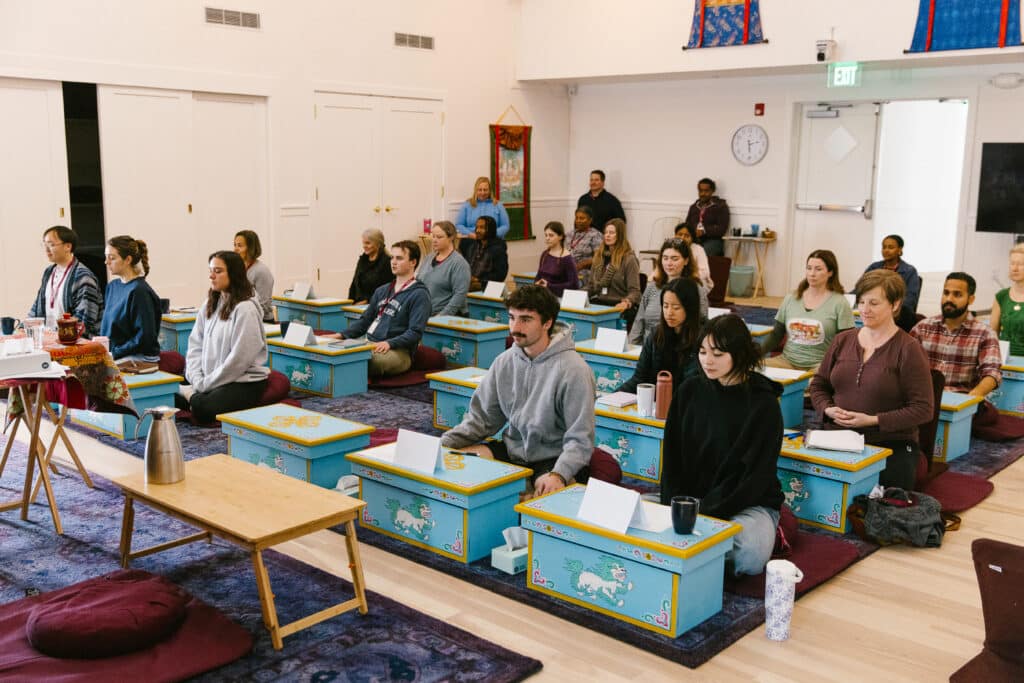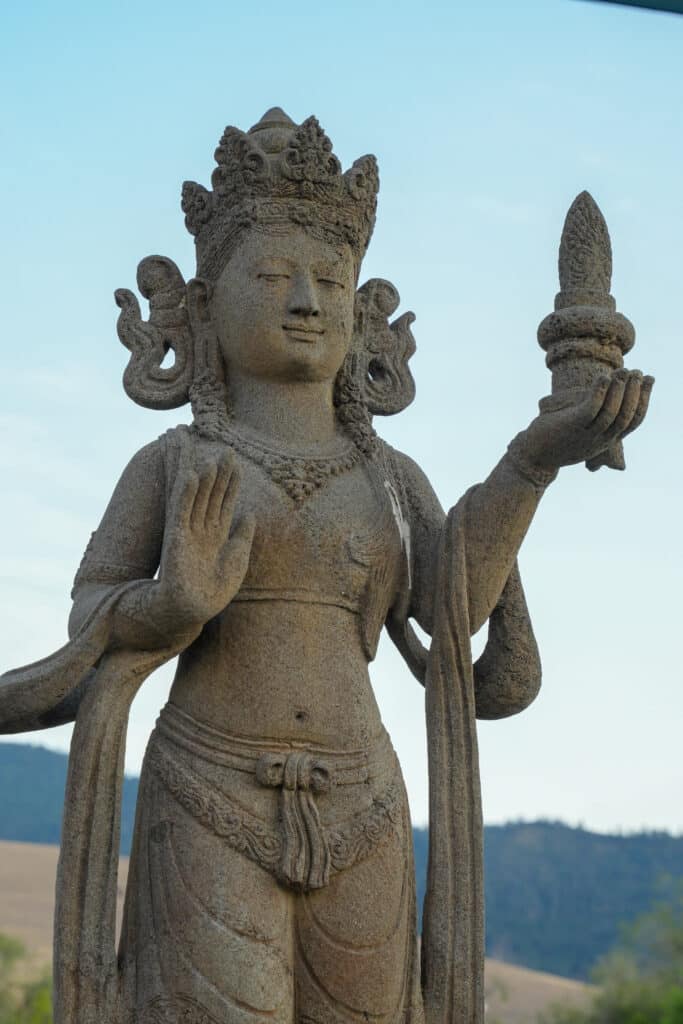For the most part, we are creatures of habit. Our lives often follow some type of routine with expected everyday norms. Sometimes it’s the people we see, the type of work we do, or the kinds of interactions we have that we become accustomed to over time. Even though we all know the common phrase, “The only constant is change,” most of us assume, usually without consciously thinking about it, that our lives will always look a certain way. This way of thinking may lead to suffering.
When our lives change in a way that seems positive, like getting a great new job, it’s natural to conjure up gratitude. Inevitably, life throws a curveball, and without warning, the entire landscape of our lives can change. An unexpected and unwanted change may be especially unsettling, as the unpredictability removes illusions of control. It’s far more difficult to feel blessed and grateful during an unwanted relationship, career change, or even some larger upending of the life we thought we had.

The period of clinging to the past and resisting the change is most likely where most of our discomfort and suffering occurs. Keep in mind that grief is a necessary part of the process. We can grieve a change while also accepting it. No one wants to suffer. Most of us want to find genuine, lasting happiness.
We know from the Four Noble Truths that suffering is inherent in this life, and that there is a way out of suffering. Read on for ideas about how to navigate these periods of change and transition and ease suffering.
Learn more about the Four Noble Truths HERE.
What is transitional stress? What is transitional anxiety?
It’s easy to talk about transitions, like a cocoon becoming a butterfly or some similar beautiful analogy. However, times of transition may simultaneously include anxiety, grief, and joy, which is a lot to feel all at once. The cocoon-to-butterfly process is not smooth or simple. In order to fly, the butterfly has to break out of the cocoon. That’s a lot of tearing! Usually there is grief in saying goodbye to whatever and whoever you’re leaving behind, even if you’re glad.
How does change affect mental health?
While life transition will be different for every individual, it inevitably brings suffering because we no longer know what is next. Most of us enjoy knowing what is to come. We tend to grasp onto the idea of certainty. When the future is unknown, we may experience increased levels of anxiety and stress.
The truth of it is that we don’t have the control of life we so dearly want—no matter how hard we try. In these times of transition, we can’t even pretend that we have that control. How frightening! Scary images of what might happen can pop up. For example, we can scare ourselves with an upcoming dental appointment, making our suffering much worse and lasting far longer than the actual physical pain of the appointment.

Tips for how to handle change and how meditation can help
You can begin by grounding yourself in the here and now. First, you might simply notice the state of your mind. In Tibetan, the term for meditation means to familiarize yourself with something. When you meditate, you’re turning your lens inward (finally!), familiarizing yourself with a state of mind and view that is a more full and accurate view of reality: The Two Truths. You notice the passing parade of thoughts and emotions (finally!). Or you’re becoming mindful of it, one might say.
The normal state of your mind is unstable, scattered, easily distracted, and easily stirred up by thoughts and emotions. And it’s so focused on the things it’s thinking and emoting about—the lens always turned outward—that it doesn’t see itself. On a deeper level, your mind is unaware of the ultimate nature of reality, that it is perfect, beautiful, and joyful. Instead, your mind is fixated on surface things, causing difficulty, stress, emotional pain, fear, anxiety, anger, and so forth. Most people are drawn to meditation out of a yearning for peace and relief from these states.
Despite all the surface distraction, maybe somewhere deep inside, we know that ultimate reality is how it’s supposed to be.
Normally, we hold tightly to, identify with, and react to whatever thoughts, emotions, or feelings arise in our minds. Every time we do that, we reinforce habits that bring pain and rob us of peace. It’s human to chase what we think is happiness and run from what we think is suffering. But how exhausting! And in the chasing and running, we usually make a lot of messes for ourselves and others.
When we take time to meditate, we cultivate habits of seeing and relating to our own inner and outer worlds in a new way that brings comfort and peace.
Meditation practices for times of transition
Lama Tsomo recommends Shamata and Tonglen in times of transition. Shamata is a foundational practice — a great starting point if you’re new to meditation, or a great place to come home to if you are an experienced meditator. When you find yourself plopped into a new chapter—new terrain—you can feel like you’re at “square one”, as life coach and author Martha Beck calls it. Begin with Shamata. Ground yourself in your breath and body so you can be present where you are.
Times of change can feel like being lost in the woods. In the realization of being lost, the most helpful thing you can do is stop and say, “I am here.” Once you feel a bit settled, even in this foreign place, Tonglen may be a helpful practice. You can begin by extending compassion to yourself in this time of transition, then expand that compassion to all people experiencing a similar transition … then to anyone in any transition. This should leave you with a sense of oneness and kinship as you remember that you are not lost nor alone.
Shamata or Calm Abiding and Vipassana (Special Insight)
On the Buddhist path, Calm Abiding serves as the foundation for all other practices. It is a technique used to develop our power of attention and bring our coarse and subtle thoughts to a restful state. In other words, it is resting or abiding in that peaceful state. We get a mini vacation from that chasing! The Nine Methods for Placing the Mind are used to develop that state of calm and single-pointed attention. Calm Abiding can bring a powerful level of calm to the mind, so much so that one could rest for long periods of time without the slightest stirring of thoughts or emotions. Calm Abiding alone cannot eliminate our afflictive mental and emotional states or give us insight into the nature of reality.
As we move into the subsequent paths of practice such as Vipassana (Special Insight) meditations on selflessness, emptiness, and so forth, Calm Abiding serves as the stable ground on which we develop insight. It is not as if we develop Calm Abiding, then toss it aside as we move to further levels of practice. It integrates into whatever practices we do. When we practice Vipassana meditation on impermanence, the insight into the nature of impermanence is Vipassana or insight, while the mind’s ability to remain single-pointedly in that insight is Shamata.
You can begin with these Shamata and body scan practices to practice observing feelings rather than grasping them. Lama Tsomo refers to Shamata as a “gentle practice”.
“When we practice Shamata, we’re spending a few minutes out of the 24 hours of breathing we do in a day being aware of—present for—our taking in of the divine and being affected and sustained by it. What better foundation for mindfulness practice? What better ushering-in to the tranquil state we’re seeking?” Lama Tsomo
It’s important to note that doing these practices does not guarantee an anxiety-free life. Instead of avoiding or suppressing our difficult feelings, we can learn to bring loving, accepting attention to whoever or whatever shows up in our minds. Rather than trying to hide from our own feelings (which never works), we can go through and out the other side. Then we feel so much more light and free!
Availing yourself of inner work and support from the outside is the winning combination, here!
Here are some more guided meditations that may be helpful:
Six-minute Meditation to Increase Happiness
Three-minute Shamata and Intro to Insight Meditation
Six-minutes of Shamata for Seeing Clearly
Tonglen (Compassion) practice for coping with change
Tonglen, the practice of sending and receiving, is a powerful way to extend compassion to yourself and others, beginning with yourself, then expanding in ever-widening circles, eventually sending compassion to all sentient beings. It’s a key practice that allows you to transform your pain and that of others—taking it away, then sending out compassion and joy. We do this using breath and visualization. Like most practices, Tonglen follows a few key steps. You can try it out HERE with a guided meditation from Lama Tsomo.
Contemplations for coping with change
You can begin by understanding—not intellectually but in your bones—the law of Impermanence. You see this in your mind when you meditate, and realize that the mind is fickle, with thoughts constantly rising and falling. In practicing the contemplation of impermanence, the goal is to develop a certainty about the nature of things. You can do this by focusing on the idea and certainty of impermanence. Then in your daily life, you can observe and take note of impermanence in the natural world around you. That beautiful tree you pass changes through the seasons? One time, long ago, it wasn’t even there. Sometime in the future it won’t be there either; its atoms and molecules rearranged into a thousand other things.
The same for your body.
Let’s look at this more closely: There are two types of impermanence: coarse and subtle. You begin contemplating coarse impermanence by looking for impermanence in action or something that started at a certain point and eventually will no longer exist. This could be by looking at the natural world and noticing changes in a body of water, or noticing how many different feelings you feel in a day or even an hour… and how many thoughts per nano-second! In doing this, consider how many locations in the world are currently forests or fields, but were once thriving civilizations or cities. You think about those beings within the world being born and dying right now. As you observe these changes, you see the impermanence of your environment.
Subtle impermanence is the slow changing, rising, and decaying from moment to moment. You could look in the mirror and reflect on the changes in your body from the time you were young up to now. You were a certain way when you were born and it’s a constant process of moment-to-moment change to get to where you are now. It’s not as if our 12-year-old self suddenly changed into our 35-year-old self; we were constantly changing. The moment-to-moment change is not observable by the human eye … yet it’s constant and inexorable.
Perhaps the most powerful part of the contemplation of impermanence is to consider the Preciousness of This Human Birth. This is the first of the Four Thoughts that Turn the Mind from Samsara. Click here for a full description. For now, focus on the first thought: the Preciousness of This Human Birth. There were many causes and effects that brought us to this very moment of reading a blog.

When we realize how precious this opportunity is, and that it could all end any moment and will certainly change, we can keep ourselves from falling into the trivial nature of everyday life. After a serious health diagnosis, many people find that previous concerns mean almost nothing, and what really matters comes rushing to the foreground. Without the usual level of distraction, many in this position talk of being held by the universe. No matter where we find ourselves, even after we die, where else would we go?
But why wait for a dire diagnosis?
We can shift our perspective now, and fully show up for our lives even in times of transition.
As you learn to navigate life changes, we encourage you to journal about the following topics:
Describe 2-3 of your observations of impermanence today.
What feelings arise while observing impermanence?
How can you apply this contemplation to your daily life?




